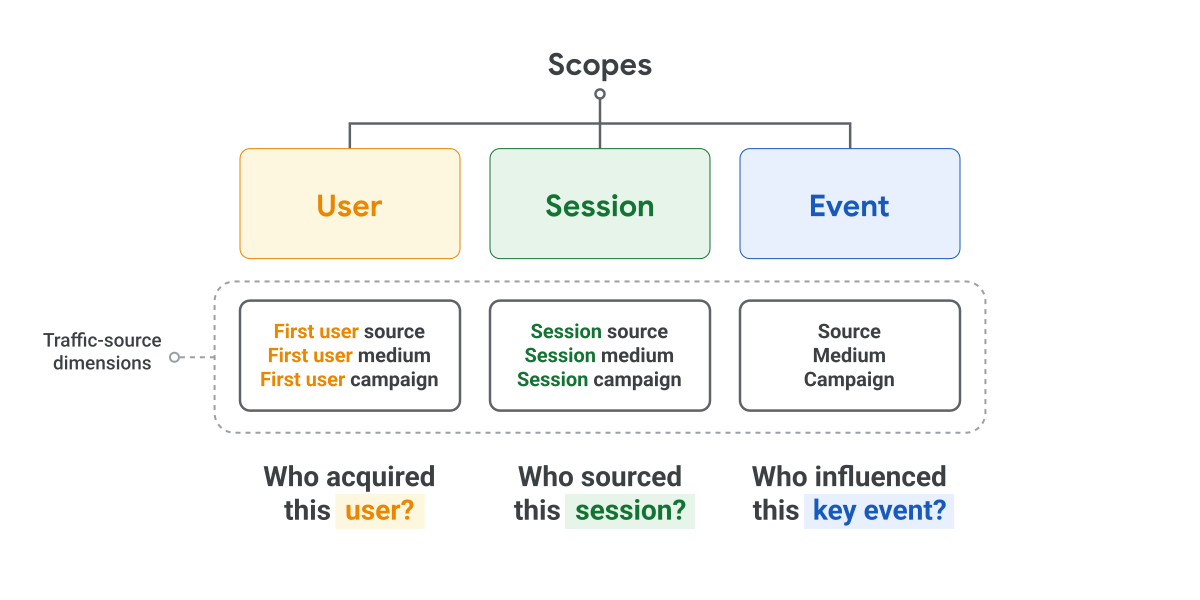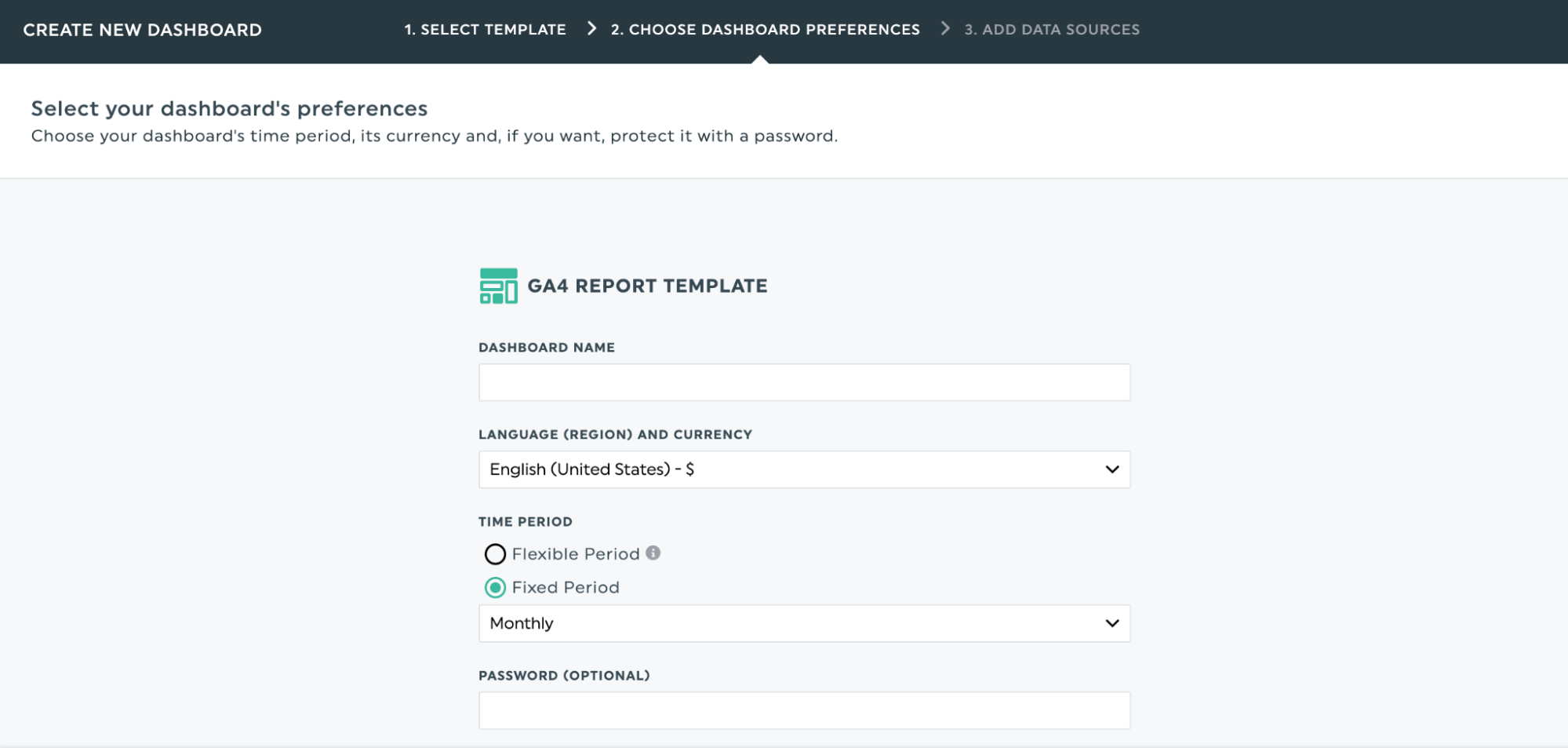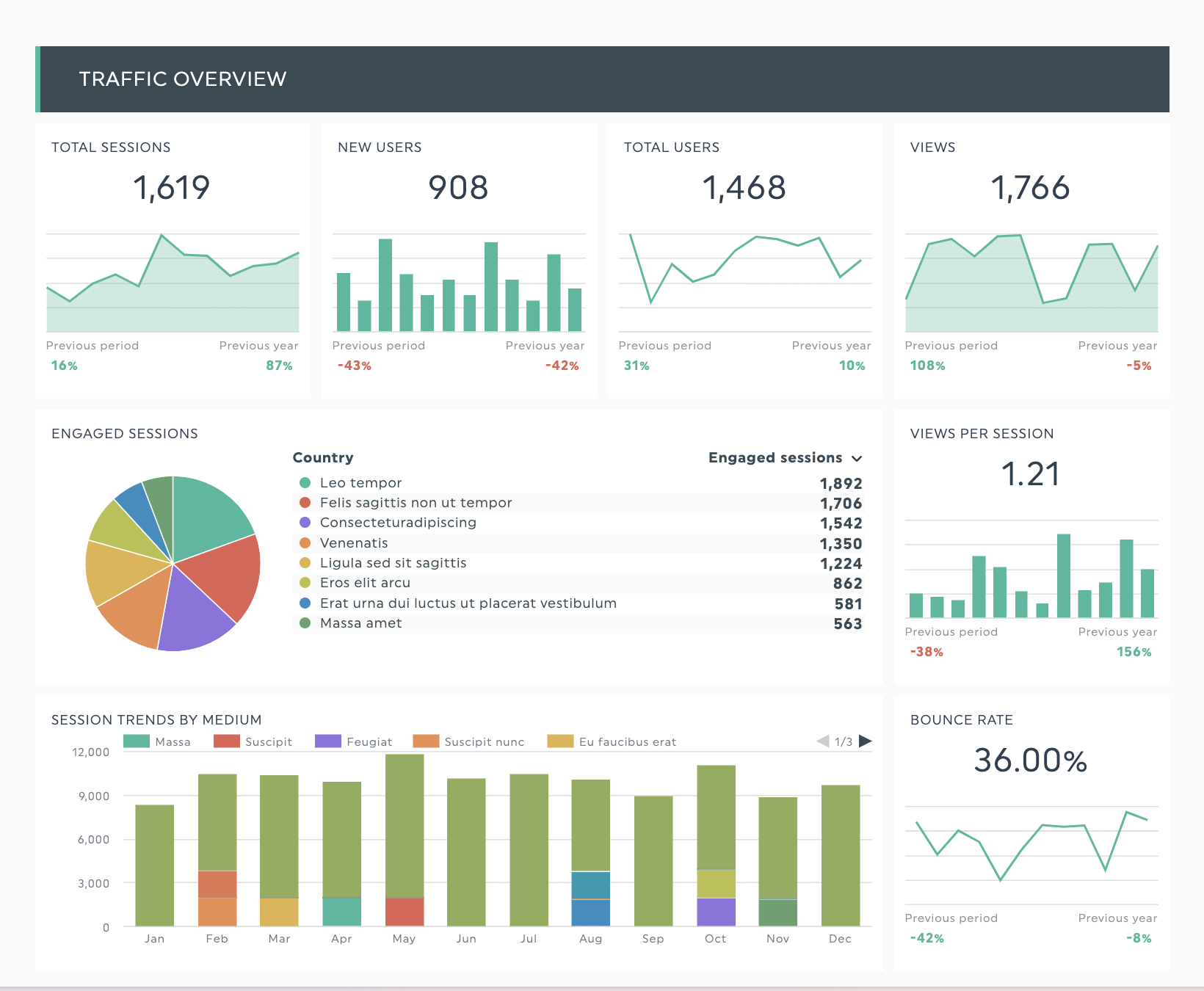GA4 scopes guide: Understanding first user vs. session in Google Analytics 4

The first user and session scope dimensions in GA4 both help you analyze your client’s user acquisition efforts in more detail.
However, it is easy to confuse the two terms, which can lead to inaccurate data analysis.
In this guide, we’ll focus on the first user and session scope dimensions in Google Analytics 4 and how you can use them to analyze your client’s user acquisition in more detail.
Table of contents
- What are scope dimensions in GA4?
- What are first user scope dimensions?
- What are session scope dimensions in GA4?
- Key differences between first user and session scope dimensions
- How to simplify scope dimension analysis with DashThis
- Automate your GA4 reporting with DashThis
What are scope dimensions in GA4?
To understand scope dimensions, let’s take a step back and understand what dimensions are in GA4.
Compared to Universal Analytics, Google Analytics 4 uses an event-based data model to track user interactions. Any interaction type, from starting a new session to viewing a new page to completing a conversion event, is tracked as separate events. This allows for more detailed tracking of individual user actions.
Dimensions add context to your data. They help you understand more about the users who visit and interact with your website. For example, dimensions in GA4 answer questions like:
- Which countries are your active users in and have the most engaged sessions?
- Which marketing campaigns triggered the most conversion events during a specific time period?
- What’s the most common age group of your users?
Dimensions are a good place to add more depth to your data analysis. What if you want to focus on a specific user characteristic or analyze behavior within a single session? For example, you may want to investigate which marketing campaign brought in site visitors with the highest initial engagement time to
That’s where scoped dimensions come in.
Think of scoped dimensions as groups of data providing different levels of data aggregation. These scopes affect how Google Analytics collects and formats the data it receives, so it’s crucial to ensure both metrics and dimensions follow the same scope level for your reports to be accurate.
Scopes in GA4 organize data on three hierarchical levels, with user scope being the highest level. One user can have many sessions, and each session can contain multiple events.
1. User scope:
What is it: Help understand a specific user in more detail.
Example: Which website or platform brought this user to your website?
2. Session scope:
What is it: Provide more context to a user’s behavior during a specific session.
Example: Which marketing campaign did a user interact to start a session on your website or app?
3. Event scope:
What is it: Analyze the interactions leading up to a user event.
Example: What was the name of the marketing campaign that influenced a key event?
This handy graphic from Google explains the differences between the three scopes in Google Analytics.

Source: Google
Now, let’s bring our attention to the first user scope and first session scope in GA4.
What are first user scope dimensions?
The First User Scope dimension in GA4 tracks data from a user’s first interaction with your site or app. It answers the question: “How did a user find your website”?
Use this scoped dimension to analyze the effectiveness of your user acquisition sources or to view how new users interact with your site.
A few practical applications include:
- Identifying the first marketing channel or campaign that leads users to your website helps inform budget allocation and content strategy
- Analyzing the total users who first come through each campaign, keyword, or marketing source gives a clearer picture of your acquisition strategies.
- Tracking the total number of users that convert into sales-qualified leads or paying customers
List of first user scope dimensions
Naturally, these dimensions all start with ‘First user’, making them easy to identify in standard reports. Here’s a quick overview of the different user scope dimensions available in GA4 and how they can help you analyze your user acquisition reports.
First User Default Channel Grouping
Identifies the type of traffic source that led users to visit your website or app for the first time. Traffic sources include organic, paid advertising, social, or direct channels.
First User Medium
Represents the first source or channel that brought the user to your website or app for the first time.
First User Source
Focuses on the specific source from which the user clicks to your website. The first user source highlights the specific referral sources, such as a website or a search engine, that drove a new user to your site.
First User Campaign
Shows the marketing campaign responsible for a user's first interaction with your website or app.
First User Ad Content
Identifies which ad in Google Ads a user clicked on to visit your website or app for the first time.
First User Ad Group
Examines broader themes in ad groups that are more effective for user acquisition. It specifies the Google Ads ad group that led to a user's first visit.
First User Keyword
Highlights which keywords a user searched for in Google, leading to their first visit to your website or app.
First User Google Ads Network Type
Shows the specific advertising network where a user's first interaction with your website or app occurred, such as the Google Display Network, Google’s organic search, or YouTube.
What are session scope dimensions in GA4
If user scope dimensions focus on analyzing data from individual users, session scope focuses on all interactions that occur during a single user visit on your site or app.
This data view becomes handy when you need to analyze new and returning user behavior in greater detail. For example, you might use session scope dimensions to answer questions like:
- How do new and returning users behave on your website or landing page during a specific time frame?
- Which channels should we attribute a conversion to?
- Are there any differences in session duration between different traffic sources?
List of session scope dimensions
Session scope dimensions always begin with ‘Session’ for easy identification. Use these dimensions to track new and returning user behavior. They can also help identify which marketing touchpoints are more effective in engaging site visitors.
Session Default Channel Grouping
This dimension categorizes traffic based on the channel that started a user's session.
Session Medium
Type of marketing channel that started the session. Example session mediums include organic traffic, CPC, or social media channels.
Session Source
The website or platform that referred the user session.
Session Campaign
The marketing campaign that started a user session.
Session Ad Content
The ad that initiated a user’s session on a website or app.
Session Ad Group
The ad group that led to the start of a session on a website or app.
Session Keyword
The specific keyword in Google Search or Google Ads that triggered a session after a link click.
Session Google Ads Network
This scope dimension shows the specific Google advertising network where a session first started. It’s handy, especially if you use tools like Google Display Network or audience network in your paid advertising strategy and want to dig deeper into your Google Ads campaign effectiveness.
Key differences between first user and session scope dimensions
How do these two scope dimensions differ, and more importantly, when do you use each one in your data analysis? Here is a good place to start.
The first user scope dimension tracks a user’s first interaction, while session scope tracks interactions within a single session
First user scope in Google Analytics 4 identifies how a user came to find your website or app for the first time, which remains constant even if the user returns to your website through a different channel. Use this scope if you want a deeper understanding of how your website acquires new users or want to fine-tune your user acquisition strategies.
In contrast, session scope dimensions emphasize activities that occur within a single session. This makes it perfect for:
- Examining user behavior and overall user activity over multiple touchpoints
- Assessing attribution
- Analyzing customer journey effectiveness.
First user scope focuses on new users, while session scope dimensions include both new and returning users
You can use these two scopes at different times, depending on your data analysis goals and marketing objectives. For example, if your client wants to improve customer retention, it's better to use session scope dimensions to capture data for both new and returning visitors.
On the other hand, first user scope might be more appropriate if you’re focusing on new user acquisition. For example, your client may be entering a new market, or you may be introducing a new product feature. In these cases, focusing on first user scope can help you measure these efforts more effectively.
How to simplify scope dimension analysis with DashThis
If that seems like a lot of data to analyze and process, it is! Reporting automation tools like DashThis can help make this process easier. Let’s explore how to do so in a few steps.
How to set up a GA4 dashboard in DashThis
First, let’s start creating your GA4 dashboard template in DashThis. After you’ve signed up for DashThis’s 15-day trial,
- Click +New Dashboard
- Select a reporting template
- Name it and click Next

After you’ve done that, connect your GA4 account (and any other marketing tools you want to analyze) as a data source. Once you’ve imported your GA4 data, use DashThis’s drag-and-drop features to customize your report.
Tip: Use DashThis’s widget bundles to add multiple data points to your report for easy analysis. When analyzing your SEO efforts, for example, adding the SEO widget bundle to your report will let you see how organic sessions compare to the overall conversion rate.
Once you’ve added the metrics relevant to your data analysis, customize your dashboard with our drag-and-drop widgets. You can also use our GA4 report template below as a starting point. Once you’re happy with how it looks, schedule and automate your reports to save even more time.
GA4 report template

Get this GA4 report template with your own data!
Use DashThis’s report template as a starting point for your GA4 reporting and help your clients make sense of the data for viewing and analysis
Key metrics included in this report template:
- Analyze user metrics like total visits, page views, and engaged sessions by source to show you which channels people interact with to find your app or website
- View session data trends by medium to track the most effective marketing channels
- Track first-user marketing campaigns by the number of conversions or engagement rate to identify the most cost-effective marketing strategies
Automate your GA4 reporting with DashThis
Knowing the differences between user and session scope dimensions in Google Analytics 4 helps prevent data errors. It also ensures you collect the right data to meet your client's digital marketing goals.
After you gather the insights to guide your client's marketing, ensure they are easy to understand. Use DashThis’s report templates to streamline the reporting process
Ready to automate your GA4 reporting?
Read More

Don’t miss out!
Automate your reports!
Bring all your marketing data into one automated report.
Try dashthis for free
